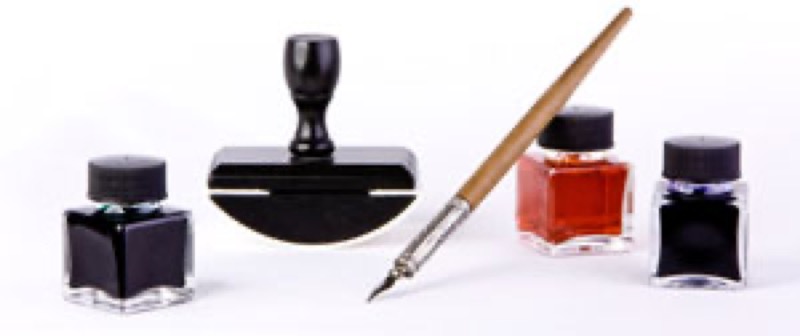Paper and something to write with: this is of course the basic equipment needed to start out in creative correspondence. Beyond these two indispensable items, the rest is up to you!
1. Hundreds of papers
- Solid color or patterned? This is the first question to ask yourself if you choose to use a classic sheet of paper.
- As for special papers, you can choose from tracing paper, metallic paper or even printed paper (leaves, flowers…).
- Budding artists may choose watercolor paper to paint an ink wash as a background.
Which weight paper? Better to choose a fairly thick paper. To maintain the thinness of traditional letter paper: 80 to 100 g/m2. For a card or an announcement: 120 g/m2 to 160g/m2. For a business card: 220 or 250 g/m2.
2. Cards and envelopes
Would you like to spend less time selecting paper? Go for simplicity: a package of envelopes and blank cards that you can customize according to your desires. They come in many colors and sizes, you are sure to find something you like.
Envelopes: should arouse the curiosity of your correspondent and make them want to discover what's inside. Choosing an envelope is not so simple…
Designed to complement the color and the size of your card, it can be square, rectangular or elongated (10.5 x 21 cm). An envelope can also surprise through an interesting texture, such as an envelope made from tracing paper that allows you to see the message inside.
And for the busiest people, why not pick out a 2 in 1 version, both card and envelope at the same time? Canson message cards® are made for you!

3. Rubber Stamps and Inks
To ink rubber or silicone stamps, you will need an acrylic block in order to apply the ink. They are perfect for highly detailed designs. You don't absolutely need a block with foam stamps, you can simply dab your stamp in acrylic paint or use a classic ink pad.
Available in many different colors, inks come in many forms: ink pads, markers, powders or liquids. Each has its own characteristics:
- Fast drying inks are perfect for rubber stamping because they provide a uniform result.
- Slow drying inks can be used for both rubber stamping and heat embossing (a stamped image, made with embossing powder: you melt the embossing powder using a heat source).
- Water based inks are ideal for coloring in a design or creating a background.
Tip: Magic powders
You can change the look of your stamped images with:
- embossing powders: heated, they create a shiny raised pattern
- flock powder, to create a velvet look

4. Calligraphy tools
Calligraphy uses a wide variety of tools. Some of the most common are:
- A feather or reed pen, which must be handled and sharpened cautiously.
- lA steel nib pen, square tipped, pointed or beveled.
- A refillable cartridge ink pen, excellent for producing thick strokes and of loops.
- Handle pens, with interchangeable nibs which allow you to make larger width lines.
- Disposable markers, practical because they come with ink.
What you need to know: Each calligraphy style has its own tools
- Chinese or Japanese calligraphy: uses paintbrushes, classified by their bristle type, goat for suppleness, or weasel for liveliness of the lines. More modern: paintbrush pens, paintbrushes with barrel reservoirs, and markers.
- Arabic and Hebrew calligraphies: traditionally use reed pens, with an oblique cut nib for Arabic, pointed for North African and straight for Hebrew.
Recommended product:
Graduate Lettering Marker
